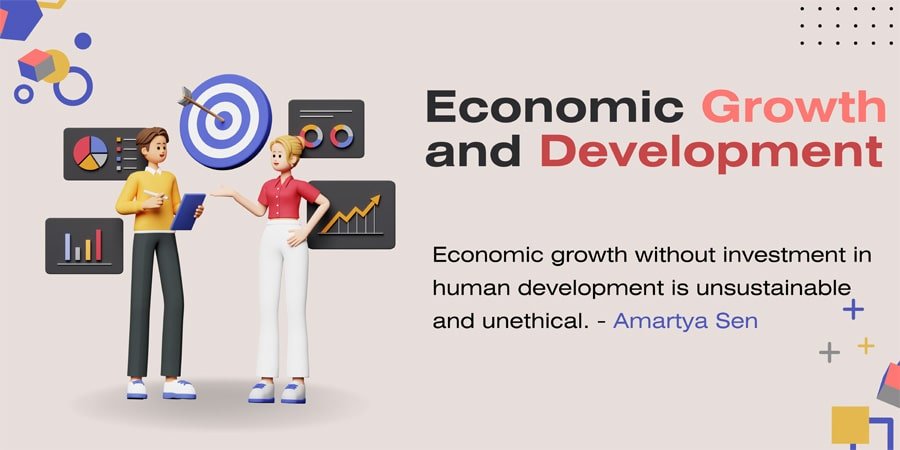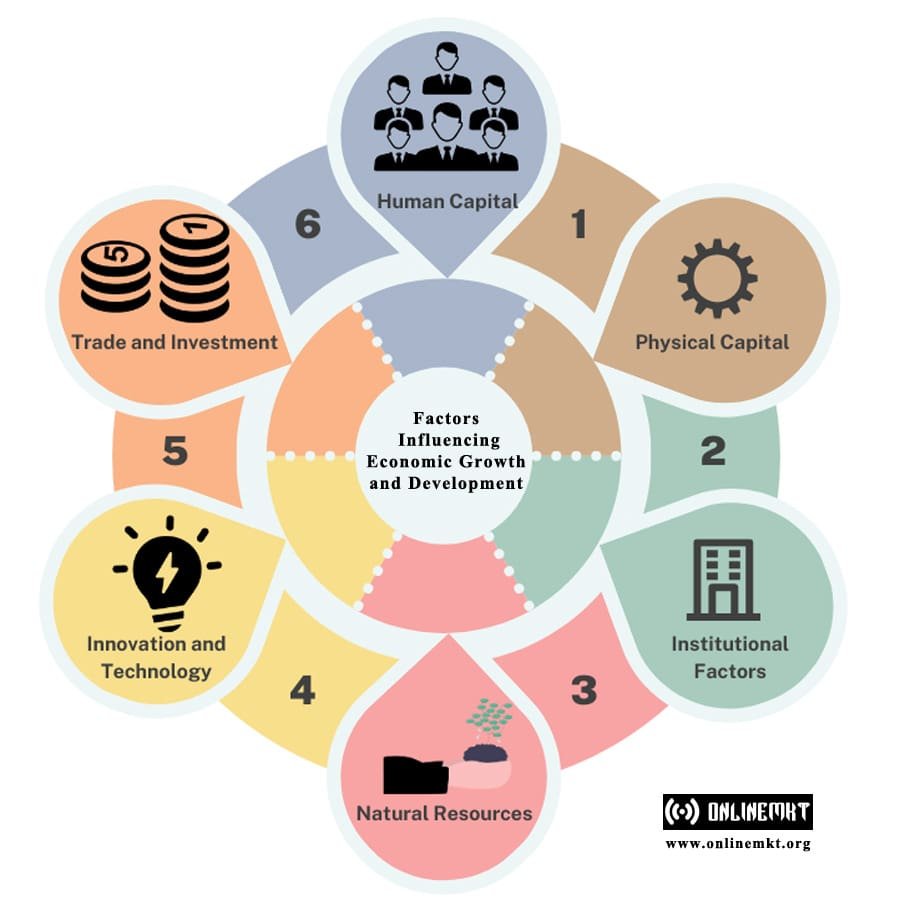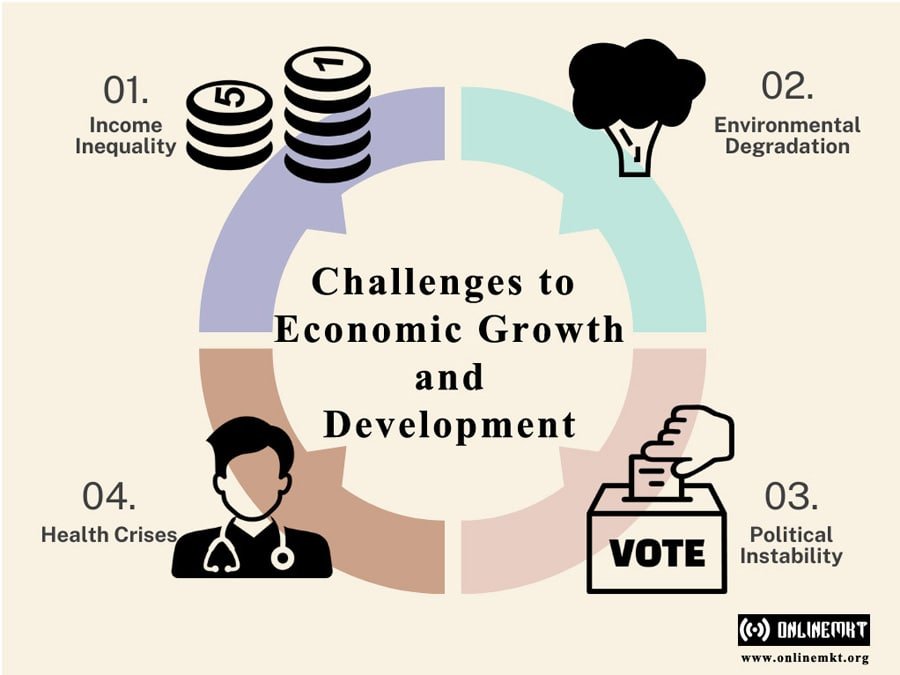Economic Growth and Development

As we navigate the 21st century, the interplay between economic growth and development remains a crucial force in shaping global dynamics.
The prosperity and well-being of humankind are dependent on two things: growth and development in an economy. Economic growth is related to increment in production, increased income, and even improved living standards.
Economic development is concerned with creating fair and sustainable economy, wherein everyone might participate in it and avail themselves of all the benefits. Thus, improving infrastructure, education, community health, and social services encourage social mobility and make a society fairer.
Economic growth and development are fundamental views on which a nation moves towards progress. Even if the two terms are often used interchangeably, one must clearly understand their different meanings:
| Economic Growth | Economic Development | |
| Concepts | Increase in a country’s output of goods and services, typically measured by GDP or GNP. | Improvements in economic well-being, quality of life, and living standards, encompassing economic growth but also social and institutional changes. |
| Measurement | Measured quantitatively through indicators like GDP, GNP, and per capita income. | Measured qualitatively and quantitatively through indicators such as the Human Development Index (HDI), poverty rates, literacy rates, and life expectancy. |
| Time Frame | Short-term increases in output and income, often assessed annually or quarterly. | Long-term perspective, focusing on sustained improvements in living standards and overall well-being over decades. |
| Focus | Emphasizes production, efficiency, and the expansion of economic activities. | Emphasizes human welfare, equitable distribution of wealth, and improvements in social and economic conditions. |
| Drivers | Driven by factors such as capital accumulation, technological advancements, increased labor force, and improved productivity. | Driven by a broader range of factors, including economic policies, social reforms, institutional changes, human capital development, and sustainable practices. |
| Indicators | Common indicators include GDP growth rate, per capita income, industrial output, and productivity. | Indicators include HDI, literacy rates, poverty rates, income distribution (Gini coefficient), access to healthcare and education, and quality of life. |
| Impact on Society | May not necessarily lead to improvements in living standards or reduction in poverty; can sometimes increase inequality. | Aims to ensure that economic progress translates into better living conditions, reduced poverty, and greater social equity. |
Factors Influencing Economic Growth and Development

Human Capital
Capacity of an individual to generate income depend on the knowledge, skills and health. It deals with building a more productive and innovative workforce through appropriate investments in education, training as well as investments in health. It causes more productivity and drives development of more advance technology. There will be more jobs with less economic inequality and a better present and future life. Human capital serves as the foundation for prosperous and sustainable economy.
Physical Capital
Physical capital in the form of machinery and infrastructure enhance productivity of an economy and its growth in general. Investments in high-quality physical capital directly translate into improvements in output. As an illustration, a chocolate factory with advanced equipment makes more from the same coconuts than the one with obsolete tools. A well-kept physical capital gives the long-term benefit and continues contribution to GDP growth.
Institutional Factors
Institutions contribute to economic growth and development. As such, these are defined by formal or informal rules, norms, and practices governing economic interactions. Factors like political stability, government effectiveness, and rule of law provide a stable environment for businesses and individuals.
The economy depends on social capital: trust and civic norms that are reciprocity. They help in collective actions and the betterment of market performance. Various studies indicate that social capital positively affects the economic development of any society.
Natural Resources
The role of natural resources is complex in economic growth and development. Although resource-rich countries have the potential to harness the natural wealth, this relationship is not always so direct. On the one hand, economies could grow through increased exports and government revenues with the help of natural resources. However, it is said that economies that are highly dependent on resources are somewhat paradoxically less likely to prosper – they are more likely to suffer the “resource curse.” Countries must, therefore, manage resources and invest in diversifying their economies in order to avoid this curse.
Innovation and Technology
Innovation, an essential factor for economic growth over the long term, is facilitated by advances in technology. Innovations in digital infrastructures, communication, and data analysis provide businesses with new avenues for growth. Global market reach, operational improvement, and data-driven strategies are possible as a result of new innovation.
New technology will always require governments, businesses, and people to keep chaning their policy, skill set, and business model practices. All of this could be achieved through collaboration, lifelong learning, and innovative policymaking. Countries may maximize the gains from innovations for sustainable economic development.
Trade and Investment
Trade and investment are vital for economy’s growth and development. Trade propels productivity growth, mainly for sectors and countries plugged into global value chains. These make it possible for developing countries to improve their operation, access to foreign technologies and know-how. Trade also speeds up the flow of technology related to a reduction in greenhouse gas emission as well adaptation to changes in climate. It has a positive effect even in the least developed countries because it increases foreign direct investment and domestic investment. FDI and domestic investment make it easier to adopt new technologies and improve the level of productivity.
Challenges to Economic Growth and Development

Income Inequality
Technological developments and the advancement of high-skill, typically drive economic growth. Such development favors very high-skilled workers and creates an income gap between these high skill workers and low skill workers. Additionally, globalization and liberalization of trade increase specialization in skilled labor industries. Lastly, urbanization also do not distribute economic benefits equally in between urban and rural population creating division in between them. It is the duty of policymakers to create balance between economic growth and inequality, by embracing inclusive development.
Environmental Degradation
Economic growth, in itself, undeniably will bring some environmental degradation because of the high demands for natural resources and energy. Industrial activities, extensive urbanization, and consumption patterns as they evolve over time have been contributing to the poor quality of the environment, causing air and water pollution, climate change, and waste generation.
Kumets Curve states that at the start of economic growth, damages to the environment will increase, then it will ultimately reduce the damage once the economy attains certain threshold. But the kind of relationship varies according to income groups; those lower-middle-income and low-income countries would show a U-shaped pattern, which implies that their economic growth would not necessarily mean improvements in environmental conditions in their contexts.
Political Instability
Rapid economic growth and development tends to cause political instability. It disturbs established social structure; promotes inequalities in wealth; and corrupts governments. These create an environment of unrest between different power group of society. But inclusive governance and fair benefits of growth would help to mitigate tension in community.
Health Crises
Economic growth and development may spread different diseases. Rapid industrialization and urbanization, which are often accompanied by increased air and water pollution, making the population susceptible to respiratory and waterborne diseases. Economic development changes lifestyles, causing chronic diseases such as obesity. Emerging infectious diseases propagate rapidly through deforestation and international travel. High population growth invariably strains health care system within a given area while creating inequality that give rise to vulnerable populations. All these issues can be tackled when environmental protection, public health, and social justice are prioritized.
Conclusion
Growth and development represent more than figures; they are the blood and guts of a vibrant society. Communities realize economic growth and development when people enjoy benefits of better jobs with handsome wages and improvements in infrastructure. When this happens, it creates better roads, better schools, and a more efficient healthcare and education system for improving overall well-being.
Sustainable development means inclusive growth. Long term goals aim at achieving environmental sustainability, social fairness, and economic viability. Thus, when resources are preserved through sustainable practices, future generations will benefit, while societies will be made more cohesive. It is about laying the ground that enable every individual to succeed, propel innovations, and development equitably.